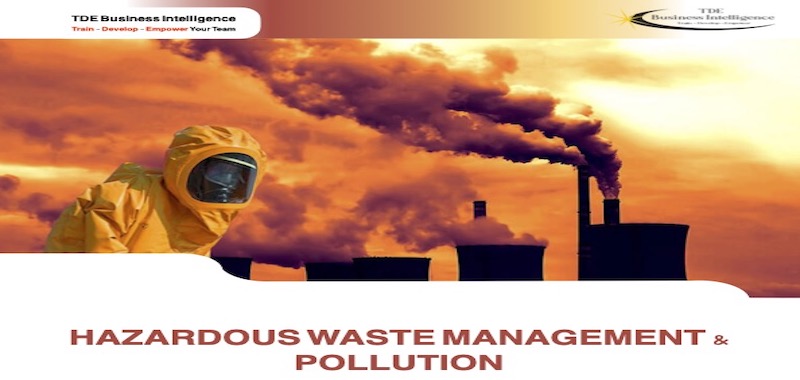
SCHEDULE
| Dates | Venue | Category |
| 7-11 August 2023 | Bangkok – Thailand | HSE-Sustainability |
INTRODUCTION
Improper storage of hazardous chemicals- both products and wastes-incompatible inspection of containment materials, using hazardous products when non-hazardous products are available and inadequate training of staff are some of the leading causes of environmental contamination. Contamination can come in many forms- Some examples of contamination are ground and surface water, land, air, radioactive, food, noise, molds, odor, construction, vibration, etc. and invariably, if these contaminants are not properly dealt with, will result in pollution and in certain situations serious health problems.
This Hazardous Waste Management and Pollution training seminar will give some details on these various types of contaminants and the new frontiers in eliminating or minimizing these contaminants, the use of effective non-hazardous products in your company and also environmentally acceptable methods of disposal for both hazardous and non-hazardous wastes.
BENEFITS OF ATTENDING
Upon the completion of this training, participants will be able to:
- Learn about the various types of contamination and which ones are more applicable to your company
- Encourage and facilitate dialogue with like-minded individuals on specific contamination issues of concern in their organizations and the opportunity to develop regional networks within the GCC area to address common concerns
- Learn about the relevant environmental treaties dealing with contamination and pollution
- Learn how to prioritize contamination problems in dealing with contamination and waste management issues in a logical sequence
- Show and emphasize the close relationship between human health and the environment that’s been directly affected by contamination
- Discussion of the current methodologies for the cleanup of contaminated soil, ground and surface water, air pollution, construction materials and radioactive materials
WHO SHOULD ATTEND?
- Health & Safety and Environmental Professionals
- Staff responsible for managing Hazardous Wastes
- Staff responsible for Contamination Issues
- Laboratory Technicians
- Staff wishing to reduce risk and liability arising from polluting events
- Technical Assistants and anyone who has a role to play in environmental matters of the Organization
- Emergency Personnel
COURSE OUTLINE
Session 1: Brief History of Contamination and Introduction to Hazardous Wastes
- What is Contamination and how does it affect us?
- A Detailed Look at All the Various Types of Contamination
- Global Environmental Issues related to Contamination
- International Environmental Treaties and Guidelines related to Contamination
- The Toxic 12 Chemicals and the Role of the United Nations Environment Program (UNEP)
- The Current Watch List for Chemicals that soon may be added to the Toxic 12
- Environmental Law and its Significance
- Definition of Hazardous Wastes & Non-Hazardous Wastes
- Connecting the Dots between Contamination and Hazardous Wastes
Session 2: Management of Contamination and Hazardous Wastes
- The Relationship between Contamination and Occupational Health & Safety
- The Importance of Documentation in Hazardous Waste Management
- Some Typical Hazardous Waste Regulations and the Need for Harmonization
- The Purpose of a Workplace Hazardous Materials Information System (WHMIS)
- The Purpose of a Material Safety Data Sheet (MSDS)
- Why a Globally Harmonized System (GHS) is Essential for WHMIS and MSDS?
- Carrying-out a Contamination Audit
- Managing a Waste Disposal Site
Session 3: Contamination and Pollution Prevention
- Exploration & Production-Refining & Transportation
- Oil Spills with Special Reference to the April 2010 Gulf of Mexico Oil Slick Occurrence
- Modern Tanker Design to Minimize the Occurrence of a Major Oil Spill
- Other Oil related Sources of Pollution
- The Common Thread amongst many Third World Countries concerning Pollution Issues
- The Current Concepts of Zero Waste (ZW) and Zero Liquid Discharge (ZLD) and their Limitations
- The Bird Problem – Pollution from Bird Droppings and Dead Birds and the Latest Available Technologies to Control this Problem
Session 4: Continuation of Contamination and Pollution Prevention Planning and Contingency Planning for Major Incidents
- Life Cycle Management of All Materials being Used in a Company
- The 5R’s – Reduce, Reuse, Recycle, Recover and Rethink
- Detailed Requirements for Proper Storage of Hazardous Materials
- The Importance of On-going Training
- The Importance of Regular Reviews of Emergency Plans
- Updated Information on ISO 14001, 18001 and 9001
- Types of Environmental Audits
- Discussion of Some Major Preventable Accidents
Session 5: Big Picture Review of the Management and Prevention of Contamination and Hazardous Wastes
- HAZID (HAZard IDentification)
- HAZOP (HAZard & OPerability)
- Environmental Ethics
- Climate Change Update and its Significance for the Gulf Coast Countries
- Recommendations including Greening your Company at a Reasonable Cost
